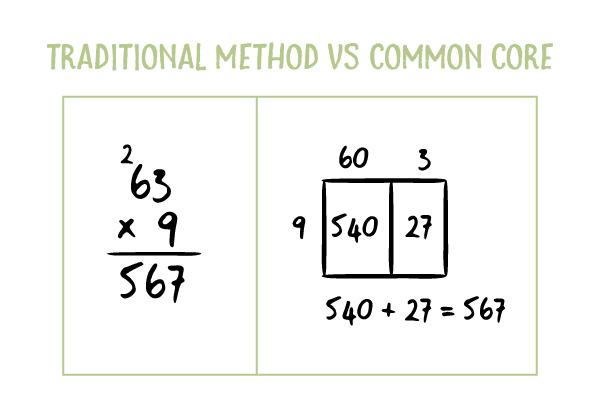
After growing up doing math problems on a chalkboard, being immersed in the world of iPads and Chromebooks can be daunting to parents. Add to that the Common Core Standards for math that involve “decomposing” and “anchoring,” and many adults are finding themselves overwhelmed and befuddled when it comes to trying to help tackle math homework or encourage their struggling elementary schooler.
What Is Common Core?
- A framework rather than a curriculum: individual schools and teachers decide the day-to-day lesson plans
- Focuses on developing critical thinking rather than memorization
- Incorporates “traditional” math (i.e. 3 x 6 or 134-96) after exploring other methods for problem solving
- Emphasizes number sense and mental math to help students prepare for college and the “real world”
Example: Rethinking Multiplication
The traditional algorithm for multiplication, often called the “longform” method, involves starting with the ones place and multiplying from right to left while using place holders and carrying. This method can be completed through rote memorization, which means you can complete the steps without picturing what you’re actually doing when you multiply.
Common Core Math utilizes the “box” or “grid” method. Here, students separate multi-digit factors into parts (63 becomes 60 and 3) and place them into boxes they have drawn. After multiplying each factor, you simply add all of the numbers together to arrive at the answer.

How Can You Help?
- Start with what’s easiest for your child. Let them feel some success and momentum before diving into what’s challenging.
- Ask, “Can you help me picture ________?” (i.e. how to decompose the number 12) Beginning with a question can help diffuse any frustration for both of you about methods that he’s learning and you aren’t yet familiar with. If your child is able to explain the concepts to you, he likely has a solid foundation.
- Offer praise to your student for showing their work — whether or not the answer is correct! A Common Core assignment may only have five problems, but the expectation often is to be able to solve those problems in a variety of ways.
- Build in breaks. If your child has trouble focusing for long periods of time, they may get frustrated with having to complete so many steps per problem. Set a time for 10-15 minutes and encourage them to get up and stretch, have a snack or chat about something that’s not math-related.
- Have “real world” math conversations throughout your daily life. Talk about how much change you get after you’ve paid at the grocery store or ask what fraction of pizza is left. Developing real-world critical thinking and application to math is a large focus of the Common Core practices.
What if She’s Falling Behind?
If it seems like your child isn’t “getting it” the way her peers are, it can be helpful to reach out to her teacher. Feel free to ask what the goals of the unit are, if what you’re seeing during homework matches what your student is able to do in class and if there are any resources or tutors she recommends.
While the goal of Common Core math is to build critical thinking and math sense, a student may still struggle if she has a weakness in concept imagery, or the ability to image and verbalize the concepts underlying math processes. Click here to learn more about how to build and strengthen concept imagery for math skills with On Cloud Nine math.
Contact your local Lindamood-Bell Learning Center to find out more about math instruction.





